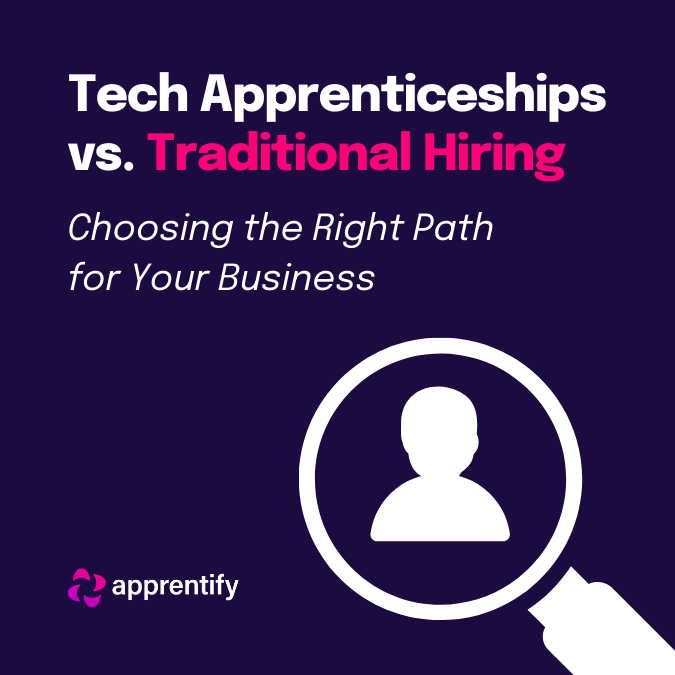Oct 13, 2023
In the fast-paced world of technology, businesses must continuously adapt to remain competitive. This evolution extends to the way we acquire talent. The debate between Tech Apprenticeships and Traditional Hiring has never been more relevant. Which path should your business choose? In this blog, we will explore the advantages and drawbacks of each approach to help you make an informed decision.
Tech Apprenticeships
Tech apprenticeships are increasingly gaining traction in the industry for various reasons. Here are some key advantages:
Hands-on Learning: Apprenticeships offer an immersive, hands-on learning experience. Candidates work on real projects, gaining practical skills that align with your company's needs.
Cost-Effective: Hiring apprentices is typically more cost-effective than bringing in experienced professionals. You can mold them to fit your specific requirements.
Customised Skillsets: Apprenticeships allow you to design training programs tailored to your organisation's unique demands. This customisation ensures that apprentices learn exactly what you need them to know.
Diversity & Inclusion: Apprenticeships promote diversity by providing opportunities to individuals from different backgrounds. This can lead to a more inclusive workplace and a broader range of perspectives.
Traditional Hiring
Traditional hiring, on the other hand, involves bringing in professionals with existing experience in the field. Here are the advantages of this approach:
Experience: Experienced hires bring proven expertise to the table. They can quickly start contributing to projects without an extensive learning curve.
Immediate Impact: These professionals are often capable of making an immediate impact on your business. Their established skill set and networks can be invaluable.
Expertise: Traditional hires often possess specialised skills and knowledge that are already refined and can provide leadership and mentorship to your team.
Predictable Results: With experienced hires, you can better predict the results you will achieve, as they come with a track record of past performance.
Nonetheless, traditional hiring has its own set of challenges:
Higher Costs: Employing experienced professionals often comes with higher salary expectations, and recruiting them can be costly.
Risk of Stagnation: Relying solely on experienced hires can lead to a lack of fresh perspectives and innovative thinking.
Which is Right for Your Business?
The choice between tech apprenticeships and traditional hiring ultimately depends on your business's goals, resources, and timeline. Many companies have found success by adopting a hybrid approach, combining the strengths of both strategies.
Apprenticeships can serve as a valuable pipeline for fresh, diverse talent, while experienced hires contribute immediate expertise and established networks.
When deciding, consider the following factors:
Your Company's Growth Stage: Early-stage start-ups might lean toward apprenticeships to minimise costs, while established companies might favor experienced hires.
Budget: Evaluate your financial capacity and allocate resources accordingly.
Project Needs: Assess the urgency of the skills you require. Apprenticeships may be best for long-term goals, while traditional hires can fulfil immediate needs.
Diversity and Innovation: Consider your company's commitment to diversity and its appetite for innovative thinking. Apprenticeships can be an excellent way to bring fresh perspectives into your team.
Mentoring Capacity: Ensure you have the resources and mentors available to train apprentices effectively.
The choice between tech apprenticeships and traditional hiring is not a one-size-fits-all decision. It's essential to align your talent acquisition strategy with your company's objectives and circumstances. Embrace innovation, evaluate your needs, and remember that adaptability is key in the tech world. By finding the right balance between these approaches, you can build a strong and dynamic workforce that propels your business to success in the ever-evolving tech landscape.



